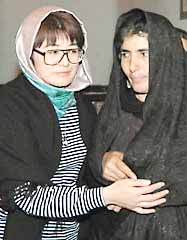Hiroshima Memo: The Lesson of Hiroshima
Feb. 22, 2008
by Akira Tashiro, Executive Director of the Hiroshima Peace Media Center
“This is the second Hiroshima.” I heard these words in April 2004, nearly four years ago, when I visited Sardasht, a city in the mountains of northwestern Iran and home to a population of ethnic minority Kurds. I had come to Iran to report on the activities of the first delegation of the Hiroshima World Peace Mission.
In 1987, during the Iran-Iraq War, the city of Sardasht was attacked by the Iraqi military with poison gas. Within a few days of an Iraqi warplane dropping seven mustard gas shells, 110 people, out of roughly 12,000 inhabitants, had died. And in Sardasht alone, about 5,000 people still suffer from such aftereffects as respiratory ailments and skin disorders.
In Iran, sufferers of poison gas have received scant attention and the international community has tended to neglect them as well. As a result, they seemed to have high expectations for this visit in 2004. In describing their experiences as “the second Hiroshima,” the people of Sardasht signified the strong emotional tie they feel to the history of our city.
Shizuko Tsuya, a member of the Peace Mission delegation, responded to the hopes of poison gas sufferers, who are plagued with health problems, by voicing her convictions to the other members of the group: “Hiroshima was helped by the rest of the world. We must not ignore these people.”
After this visit to Iran, Ms. Tsuya initiated exchange activities with the Iranian people as she continued her work as a pharmacist. In fact, her passion and determination to act on behalf of poison gas sufferers in Iran has gradually attracted the involvement of Hiroshima physicians. The culmination of these activities, to date, is the recent medical exchange project with Iranian doctors and nurses who treat victims of poison gas.
Ms. Tsuya, originally from Niigata, moved to Hiroshima after marriage. Her father-in-law, a doctor, often told her about the relief activities that took place after the atomic bombing, such as Dr. Marcel Junod, a Swiss physician, who delivered 15 tons of medical supplies for the A-bomb victims in the aftermath of the bombing.
“I see the mission of Hiroshima as not only about conveying the horrible reality of A-bomb devastation to the world,” Ms. Tsuya commented. “At the same time, we need to reach out our support to victims of war and conflict.” This is the “lesson of Hiroshima” that her father-in-law, who died in 2001 at the age of 75, taught her to embrace. And this is the sort of city, a “city of humanitarian spirit,” that Hiroshima should embody.
“This is the second Hiroshima.” I heard these words in April 2004, nearly four years ago, when I visited Sardasht, a city in the mountains of northwestern Iran and home to a population of ethnic minority Kurds. I had come to Iran to report on the activities of the first delegation of the Hiroshima World Peace Mission.
In 1987, during the Iran-Iraq War, the city of Sardasht was attacked by the Iraqi military with poison gas. Within a few days of an Iraqi warplane dropping seven mustard gas shells, 110 people, out of roughly 12,000 inhabitants, had died. And in Sardasht alone, about 5,000 people still suffer from such aftereffects as respiratory ailments and skin disorders.
In Iran, sufferers of poison gas have received scant attention and the international community has tended to neglect them as well. As a result, they seemed to have high expectations for this visit in 2004. In describing their experiences as “the second Hiroshima,” the people of Sardasht signified the strong emotional tie they feel to the history of our city.
Shizuko Tsuya, a member of the Peace Mission delegation, responded to the hopes of poison gas sufferers, who are plagued with health problems, by voicing her convictions to the other members of the group: “Hiroshima was helped by the rest of the world. We must not ignore these people.”
After this visit to Iran, Ms. Tsuya initiated exchange activities with the Iranian people as she continued her work as a pharmacist. In fact, her passion and determination to act on behalf of poison gas sufferers in Iran has gradually attracted the involvement of Hiroshima physicians. The culmination of these activities, to date, is the recent medical exchange project with Iranian doctors and nurses who treat victims of poison gas.
Ms. Tsuya, originally from Niigata, moved to Hiroshima after marriage. Her father-in-law, a doctor, often told her about the relief activities that took place after the atomic bombing, such as Dr. Marcel Junod, a Swiss physician, who delivered 15 tons of medical supplies for the A-bomb victims in the aftermath of the bombing.
“I see the mission of Hiroshima as not only about conveying the horrible reality of A-bomb devastation to the world,” Ms. Tsuya commented. “At the same time, we need to reach out our support to victims of war and conflict.” This is the “lesson of Hiroshima” that her father-in-law, who died in 2001 at the age of 75, taught her to embrace. And this is the sort of city, a “city of humanitarian spirit,” that Hiroshima should embody.







